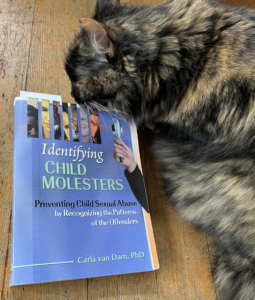I just finished reading Identifying Child Molesters: Preventing Child Sexual Abuse by Recognizing the Patterns of the Offenders, by Carla van Dam, Ph.D. This book was published over 20 years ago, yet it seems oddly contemporary. It’s obvious that a lot of the examples she uses are old: some individuals and organizations named have faded into obscurity, technology has changed, and laws involving pedophilia are updated. Yet  the process by which assailants groom their targets, in fact often groom communities, is still alive and kicking. By grooming, I mean how wanna-be molesters get chummy with parents, teachers, and other community members to gain access to children, and how they cultivate relationships with the kids.
the process by which assailants groom their targets, in fact often groom communities, is still alive and kicking. By grooming, I mean how wanna-be molesters get chummy with parents, teachers, and other community members to gain access to children, and how they cultivate relationships with the kids.
Earlier this year I taught a Safety Skills class for children (ages 5-8) and parents. One exercise was to have the kids go to the parent and tell them a neighbor had invited them to come over to see their new tropical fish. The next exercise was for the parents: they were to approach that neighbor (role-played by me), and let me know it’s not okay to invite their child over without direct and immediate parental permission. It was surprisingly hard for most of the parents to get the words out, even with prompting. Yet this is probably the most critical link to break in the chain of events leading to child molestation.
That is a huge challenge around identifying child molesters. Non-aggressive confrontation seems to be hard for too many people. Yet the long-term consequences are even harder. It’s so difficult, now and throughout history, to acknowledge that someone we thought we knew and may like, who has been helpful and kind, has also been abusive. We like to believe that molesters are evil monsters, badness runs through everything they touch, and their true character is obvious.
Not true.
Mostly we’re gambling. Betting that that person whose actions and words sometimes cause us discomfort is just socially awkward. Betting that abuse and manipulation happens to other people. Betting that we are too smart and aware and educated, that we can readily spot the baddies. But only once we’re sure, because we don’t want to embarrass someone or wreck their career needlessly.
Once we are sure, however, it’s too late.
As Dr. van Dam wrote, “Learning to say ‘no’ with grace and certainty to those whose behavior seems problematical does not interfere with friendships, but does send potential molesters away. Those who are interested in opportunities to molest children will not invest their time with adults who do not tolerate their charm.”
You can learn to be one of those adults, and practice some skills in our classes.
Stay safe, live life.

